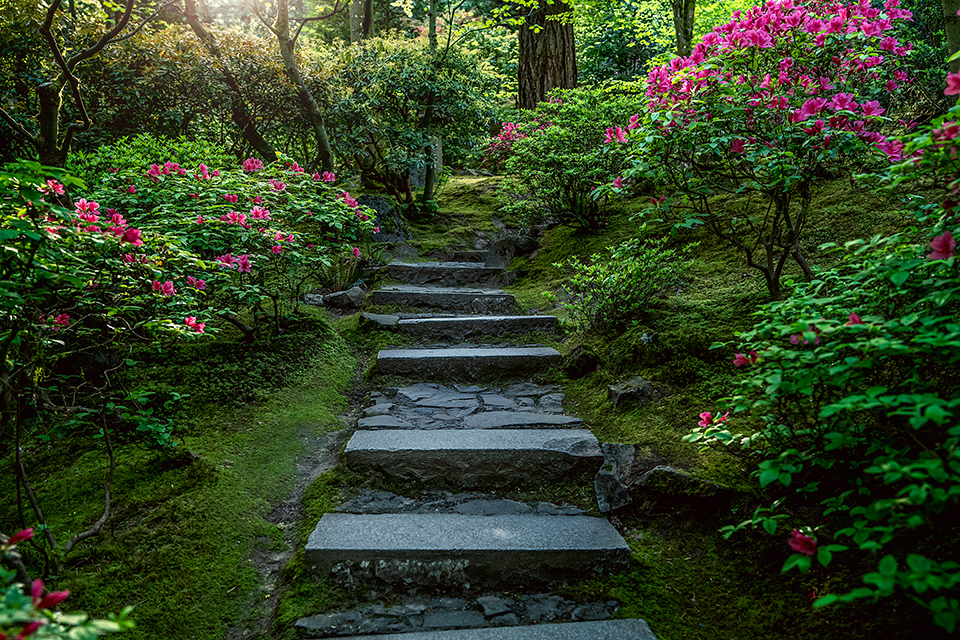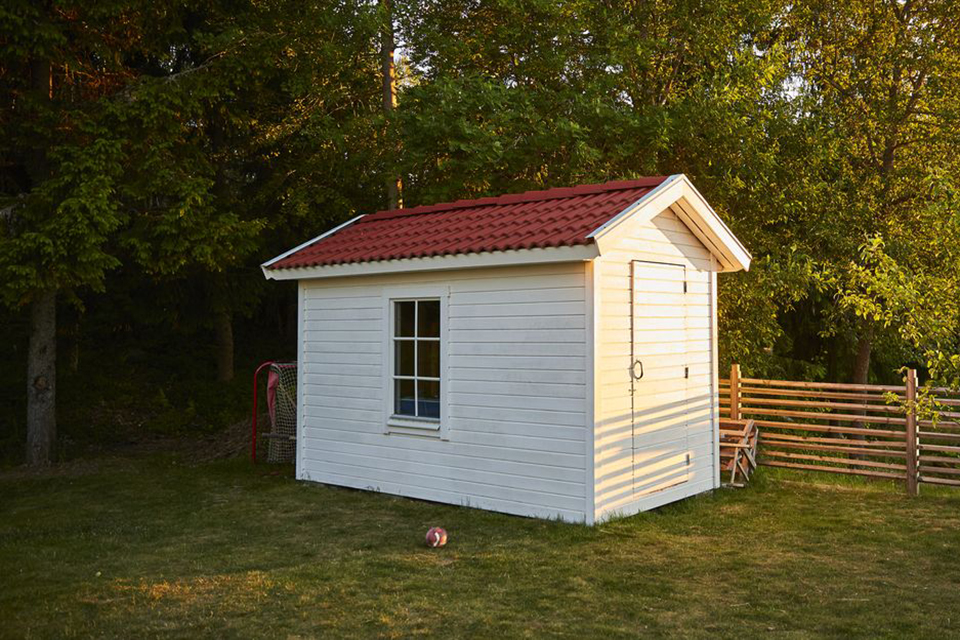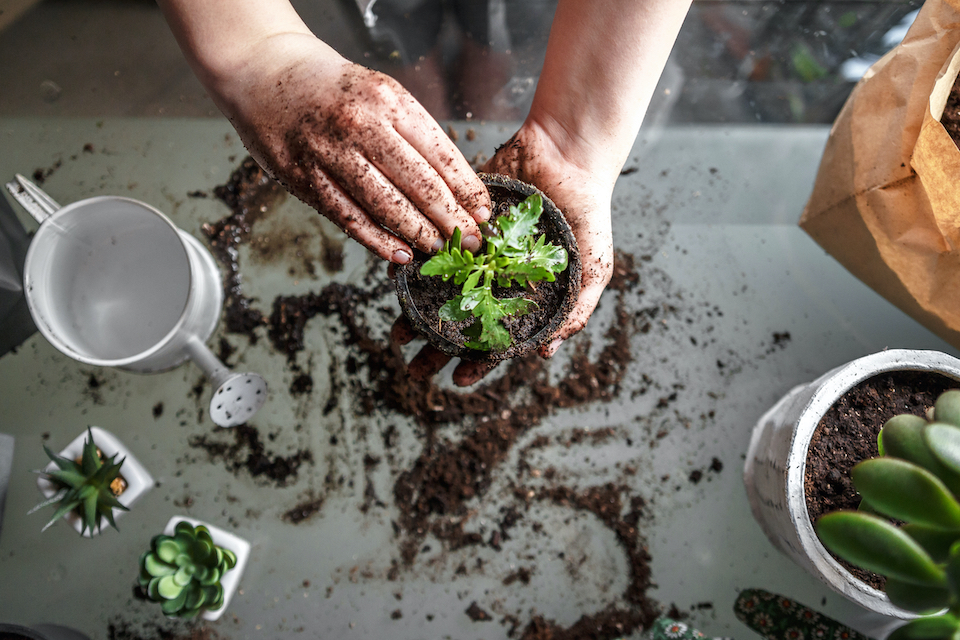Introduction
Are you planning to construct your very own garden pond? In the following article, we’ll break down what this entails and other relevant topics such as the benefits of a pond and choosing the perfect plants to go with your pond. The following guide will prove very useful if you intend to build one or are considering it in the future!
What Are the Benefits of a Pond?

First, let’s take a look at various advantages of fitting a pond in your garden. In each of the following subsections, we’ll explain what each of these benefits entails.
Water Conservation
Plants which are soil-based and lawns need plenty of watering. Since ponds will accumulate rainwater with time, this water can be used to water your garden. You could achieve this by simply placing a watering can in the pond to collect some water. If there is fish in your pond, just be careful not to scoop them up in the process accidentally! Ponds can also provide a self-sustained hydration cycle which helps to keep plants healthy without needing to water them directly. If there is a season when rainfall is lower than usual, you could reposition the drain pipes so that it’ll empty right into the pond, acting as a natural reservoir. Ultimately, pond water conservation can mean lower utility bills.
Support Local Wildlife
Ponds can attract a range of wildlife including turtles, frogs and insects. They can also be the perfect habitat for fish including koi, goldfish, golden orfe and plecostomus. Tadpoles are usually a positive addition to a wildlife pond since they consume algae. Adult toads on the other hand help with insect control in a garden.
Calming Environment
Ponds like water features in general can also create a tranquil environment. Of course, the pond itself will offer a more natural aesthetic to your garden while the wildlife it attracts will support this even further. If you have any trickling or flowing water as part of this pond, these sounds will not only help with producing relaxing sensations but can also drown out or minimise other sounds nearby.
Garden Appearance
Of course, a pond can also help with the appearance of your garden in general. A pond can really add character to a garden and give it a new lease of life. It can act as a beautiful central feature of a garden.
Air Quality
As with any water feature, a pond can improve the quality of air in your garden. This is possible due to the negative ions which result from water. These particles can pull pollen, dust, toxins and other harmful or problematic residues from the air.
Natural Fertiliser
The sludge which gathers in a pond’s filter may seem like an inconvenience if anything. However, it is a fantastic way to fertilise your garden naturally. That way, you can avoid using more harmful man-made products. Not only is this more eco-friendly but of course it can also save you money.
Things You Need to Consider

Before constructing a pond, there is plenty that you’ll need to keep in mind. Each of the following considerations should be explored before you draw up plans for your new pond.
Pond Plants
Firstly, what plants, if any, would you like to include? There are various types of plants which you could add. The ideal plants based on each type will vary depending on the pond depth. Marginal plants, as you may imagine, cover the margins of the pond and can help restrict the growth of algae, particularly in warm and shallow water. Then there are submerged plants, also known as oxygenators. During sunlight, they produce oxygen while acting as a suitable night-time cover for any water life dwelling in your pond. Some of the most popular pond plants are floating ones. They help to discourage algae by keeping the water cooler. You should keep about half of the pond’s surface clear of any vegetation. You may need to thin out plant life for your pond during the summer months. Beyond that, you may also wish to add several waterlilies as an additional aesthetic touch. In the case of marginal plants or waterlilies, certain species are suited to different depths. We discuss this in further detail and give some examples in the ‘choosing pond plants’ section, later in the article.
Pond Fish
Once you’ve put plenty of thought into the plants you’ll choose for your garden pond, you should then contemplate whether or not you’d like to add fish. Firstly, the pond should be at least 60cm in depth for it to be a suitable habitat for aquatic life. As for choosing the right type of pond fish, surface fish are those which swim closer to the surface and there are ‘eye-catching fish’ which do not camouflage and hide out of view as easily as others. You’ll also want to ensure that the fish do not reproduce too quickly as the pond’s fish population could quickly get out of hand. So this is another important consideration.
If you choose to include fish that catch the eye, it’s essential that you add protection to ensure they won’t be hunted by birds such as herons that are notorious for stealing pond fish. Fences, whether electric or not, and tripwires are good ways of securing a pond. Some tripwires come with bells that will go off and are designed to scare away any potential predators. Fish tiles and pond crop netting may also be used. Of course in taking care of your pond fish, it’s also important that you educate yourself in what specific feeding requirements any given species have. You should also take this into account if you’d like to include two or more fish species. Also, be aware that mixing different fish species in a given pond does come with various risks, including that the bigger fish may consume the smaller ones. So all in all, just make sure to do plenty of research before introducing fish to your pond. That way you’ll keep the risk of things going wrong to a minimum!
- Goldfish
- Koi
- Algae Eater
- Fathead Minnow
- Sunfish
- Sturgeon
- Golden Orfes
- Golden Tench
- Rosette
Pump
You’ll also need to consider what type of pump will suit your pond design as these are essential pond supplies. There are various types of pond pumps which you could purchase and the ones that you’ll need or at least may prefer will depend on the size of the pond and aspects such as whether or not there are fish present. As a rule of thumb, a pond pump should have a gallon per hour (GPH) rating that is at least half of the pond size. This is because pond water should circulate roughly every two hours. An intermittent pump is suitable for a pond that does not include fish, but if there is aquatic life in your pond then a continuous-duty pump will be necessary. If you have a fish pond, a filtration system would also be a wise choice.
It’s also important to weigh up the pros and cons of a submerged pump versus a surface pump. Submersible pond pumps do not require a high level of voltage and are usually most suited for small to mid-sized garden ponds. For larger ponds, you should install a surface pump. It will need well ventilated dry housing that is also easy to access. For a more hi-tech option, you could buy an adjustable flow pump. This type of pump comes with a remote control which allows you to raise or lower the flow rate of the waterfall and therefore its sound level. These are just some ideas for pond pumps. Either way, make sure to do your research and find the right options for your pond.
Size
As mentioned earlier, certain fish and plant species are more suited to different pond depths. The deeper a pond, the more strenuous a construction project it’ll be in bringing one to life. However, pond size will not only be determined by depth but of course, the width and length of the structure too. Choosing the right pond size for your garden will depend on how much room you have, how much space you’re willing to use up and how the largeness of the pond will fit into your garden aesthetically.
The larger the pond, the more challenging it could be to manage. While a big pond may add more aesthetic value to your garden, it will likely mean spending more on pumps, more time spent on maintenance and pond management and a higher cost if any problems need fixing that arise with the pond over time. Ultimately, this is a matter of pros and cons, and you’ll need to weigh these up when picking the ideal pond size for your garden.
Location
Another critical point of consideration is where you’d like to locate your pond. What you ideally want is a pond that is open, sitting on a level surface, south-facing and well-drained. This is especially true if you intend on having a life-filled pond. Also, it’s best to keep the pond away from shaded areas such as next to large trees although you’ll also want to find a spot in your garden that is not significantly exposed to heavy and prevailing winds. Lastly, you’re also going to want to find a position for your pond that is aesthetically pleasing both as seen from within your home and outside in the garden.
How to Build a Pond
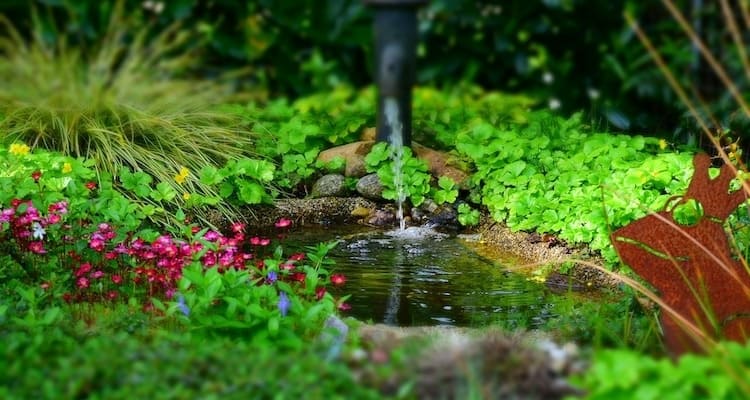
So, we’ve considered what’s needed for a pond and the various advantages that constructing one entails. We’ll now look at how to make a pond including a break down of the tools, equipment and steps involved in creating one!
Tools Needed
There are plenty of tools that you’ll require for building a pond. From the two lists given below, you may not need every single tool mentioned, but in many cases these will all prove necessary.
For Preparation:
- Garden hose or rope - Needed to layout the pond shape
- Marking tool (e.g. spray paint or chalk)
- Wheelbarrow - For carrying materials and equipment
- Square spade
- Round shovel
- Level
- Rake
Optional Construction Tools:
- Skimmer
Equipment and Materials Needed
Once you have the required tools, you’ll need to acquire certain materials and equipment to prepare or/and construct the pond.
For Preparation:
- Straight board (must cover the length and width of the pond)
- Preparation materials (e.g. gravel or fine sand)
For Construction:
- Pond Liner - Impenetrable membrane covering used to retain liquids
- Construction materials (i.e. heavy rocks or bricks)
- Pump
- Filter - Keeps a pond clear of debris, algae, etc.
- Pipes, tubing and fitting
- Water
- Pond edge material - Helps to conceal the pond liner and blend the bond into the garden
Optional Construction Equipment:
- Aerator - Circulates water and inputs dissolved particles of oxygen
- Heater
- Lighting
Building a Pond
Let’s now break down the steps involved in creating a garden pond. The exact nature of each of these steps can vary depending on the size and exact layout or design of the pond.
1. Choose a Location and Draw Up Plans
As discussed earlier, you’ll need to pick a good location for the pond. It should be one that is suitable in terms of aesthetics and which has good access to sunlight, a level surface and good drainage. The location will be important as you develop and draw up the design for your pond. This process should involve choosing the depth of the pond as well as its width and length. In addition, you’ll need to consider what materials you’ll require and what exact shape the pond will take. Whether it is small wildlife pond ideas that you need to consider or those for a medium or large pond, research is vital.
2. Preparation Work
Before construction can begin, you’ll need to mark out the outer pond area. At this time, you should have all of the tools and equipment needed on standby. This is also a good time to start laying out the straight board, if necessary. You should also acquire a wheelbarrow so that the materials can be carried with ease.
3. Digging
Once the outer pond area has been marked, you can start digging this up as per your plans. You can establish the shape of the pond on the surface with sand, spray marker or string. Once you’re pleased with the outer shape, digging can begin. You should start from the perimeter using a spade and gradually dig inwards. Then, you may remove the inner soil section. If you wish to include a marginal shelf for plants, then you should dig to a depth of approximately 30cm as per the outer area of the pond.
Next, you’ll need to mark out and dig the deeper water zone. As you dig this area which will reach the full depth of the pond, make sure that the sides of your pond slope inwards. This is instrumental in preventing soil collapse. Usually, there should be around a marginal zone perimeter shelf of about 30cm to 50cm. This should provide the correct amount of space for planting basked to be fitted on as soon as the liner is added. If you plan on adding a waterfall or stream of some kind, you could use a certain amount of the excited soil for establishing a raised bank. This could then be covered with a flexible liner.
4. Establish a Top Trench
Next, you should consider constructing a small trench along the perimeter at the top part of the pond. This can help stop the water saturating the soil which surrounds it.
5. Measure and Choose a Pond Liner
Assuming that you’ve chosen an appropriate pond liner, you’ll now need to measure out how much will be required. A flexible measuring tape or string can be used to make the necessary measurements. You should start at about half a metre from the edge of the pond. This will account for any folding and pleating. Follow the pond’s contours with the tape or string. The measurement should stop at about half a metre from the pond’s edge on the other side. The distance from point A to point B will tell you the length needed for the liner. Then repeat this step to determine the liner width.
6. Fit the Underlay and Pond Liner
Before fitting the pond liner, you’ll need to add protective underlay. You should allow for a minimum of 15-20cm overlap between the sheets. This will make for the most durable underlay. A scissors or sharp knife can be used to cut off any excess pond underlay. Then, as per the measurements calculated in step five, lay down the pond liner. You may also wish to add a decorative stone liner. This will help conceal the appearance of the original pond liner.
7. Install the Pond’s Fittings and Features
At this point, you can add the pond pumps and filter as well as any other fittings you’d like to include, whether it be an aerator, heater or/and lighting. For this stage, you may also fit any features such as a stream or waterfall.
8. Add Water
As long as everything looks okay, you can start adding the water. This can be done with a garden hose. You may need an additional person to help at this point, in case the pond liner needs to be moved and adjusted to ensure that the water is filling the pond correctly.
9. Create a Border of Stones or Rocks
Once the water has been added, you can start covering the perimeter with stones or/and rocks. Feel free to get creative and establish a design that you like best.
10. Add the Plants and Fish
You can now add any appropriate plants depending on the depth of the pond you’ve constructed (see the next section for examples). Once the pond has been tested and checked to ensure that all is working okay, including the pumps, filters, etc. you may also add fish to your pond. And there you have it, you’ve just created your very own garden pond!
Choosing Pond Plants
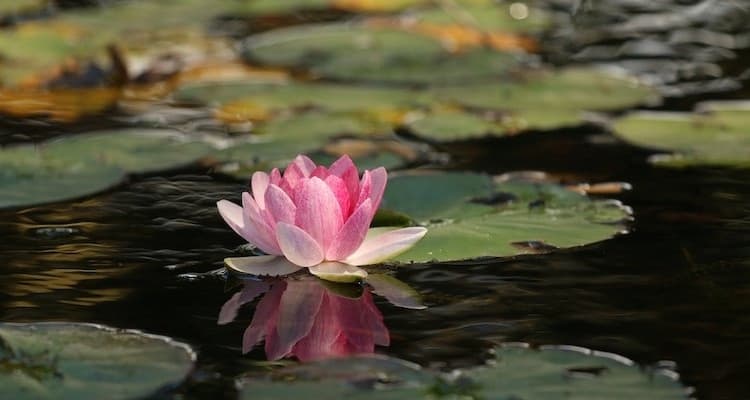
We talked a little about the different types of pond plants earlier. Let’s take a deeper look into some examples of plant pond ideas based on these various categories.
Fully Submerged
So first, we have entirely submerged pond plants, also known as oxygenating pond plants. These plant types are great to stave off algae since they compete and often win out in the fight for nutrients. Submerged plants are essential if you want to establish a well-balanced ecosystem for fish and any other aquatic life forms living in or around your pond.
Popular Examples:
- Hornwort
- Arrowhead
- Willow Moss
- Frog’s Lettuce
- Water Violet
- Red Rotala
- Waterweed
Floating Pond Plants
These plants are often partially submerged, but their leaves float on the surface of the pond. All of their nutrients are taken from the water directly without the need for soil. Not only can they hide fish and other aquatic life from predators, but they will often act as a beautiful addition to any pond.
Popular Examples:
- Ivy-leaved Duckweed
- Azolla Mexicana
- Fairy Moss
- Frogbit
- Water Soldier
- Water Hyacinth
Emergent Pond Plants
As you may have guessed, these plants grow from beneath the water until they reach a certain height and emerge above the surface of the water. They can add a wonderful, natural touch to your garden pond.
Popular Examples:
- Alligator Weed
- Cattails
- Elephant Ears
- Lizard’s Tail
- Smartweed
- Water Primrose
- Tape Grass
Marginal Pond Plants
Next, we have marginal plants. They are meant to be grown in the shallow edges of a pond and in many cases, they’re grown in planting baskets. Marginal pond plants help to add shape to the edge of a garden pond while also adding swashes of colours during their flowering season. Unlike for the previous plant categories, the plants you can choose will depend heavily on the depth on the pond.
Popular Examples (Based on Depth):
| <5cm and mud | 5 to 15cm | 15 to 30cm | 30cm or more |
|---|---|---|---|
| Marsh Marigold | Sweet Flag | Lesser Spearwort | Great Water Plantain |
| Golden Buttons | Bog Arum | Arum Lily | Water Hawthorn |
| Acorus Gramineus Variegatus | Flowering Rush | Bog Bean | - |
| Carex Pendula | Yellow Flag | Dullchlum Arundlnaceum | - |
| Acorus Gramineus Var Pusillus | Glyceria Maxima Var. Variegata | Pontederla Cordata Blue | - |
| Japanese Water Iris | Corkscrew Rush | Pontederia Dilatata | - |
| Lizard’s Tail | Pickerel Weed | - | - |
| Bowles’ Golden Sedge | Zebra Rush | - | - |
Waterlilies
Lastly, we have waterlilies. These are often included primarily for aesthetic reasons, but they can also help regulate pond temperature by limiting sunlight during the summer. As with marginal pond plants, certain species are most suited to any given pond depending on how deep it is.
Popular Examples (Based on Depth):
| 10cm to 30cm | 30 to 45cm | 45 to 75cm | 75cm to 120cm |
|---|---|---|---|
| Nymphaea Odorata Var Minor | N. Aurora | N. James Brydon AGM | N. Alba |
| N. Pygmaea Helvola AGM | N. Ellisiana | N. Gonnere AGM | N. Attraction |
| N. Tetragona | N. Indiana | N. Marliacea Chromatella AGM | N. Ambailis |
| N. Pygmaea Rubra | N. Lucidia | N. Marliacea Carnea | N. Gladstoneana AGM |
| - | N. Pink Sensation | N. Rose Arey | N. Escaboucle AGM |
| - | N. Caroliniana Nivea | N. William Falconer | - |
| - | N. Charlene Strawn | - | - |
What Wildlife Can Ponds Encourage?
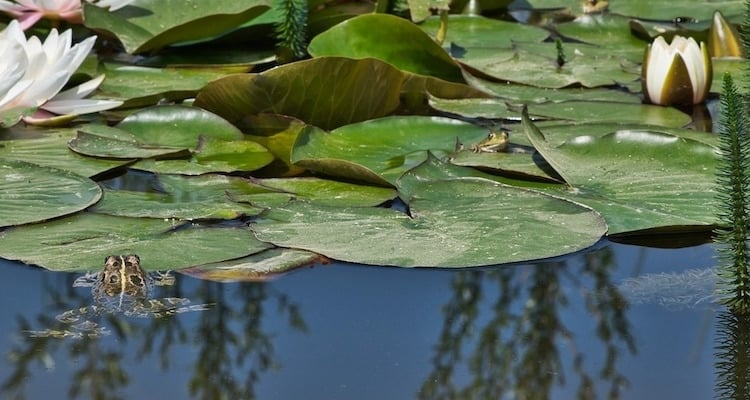
One of the best advantages of having a pond is the wildlife that it can attract. We touched on this earlier but let’s take a look at some prominent examples in more detail.
Frogs, Toads and Newts
A range of amphibian species are attracted to ponds. These water critters can thrive in a garden pond since it acts as a stable, regulated and dependable environment to live in. These aquatic animals often use small water bodies to reproduce. As a result, a small wildlife pond is perfect for attracting these animals. It can also be a win-win since adult toads will consume insects, helping to control their numbers in your garden while tadpoles have a habit of eating algae.
Dragonflies
You’ll find that dragonflies will appear in increasing numbers in your garden once you’ve built a pond. They breed in bodies of water and their larvae require submerged plants for developing.
Hedgehogs
These Erinaceidae sometimes turn to garden ponds to rehydrate or/and cool down during warm weather. However, it’s important that you create an exit point for hedgehogs to get out of the pond. Otherwise, they can suffer from exhaustion and drown. This can be prevented by creating a gentle slope or by laying a plank down as an exit ramp. One of the cons to pond netting is that it could trap hedgehogs. So, you’ll need to weigh this up when drawing up your plans. You may prefer to just include well-camouflaged fish and no pond netting to protect both the fish and hedgehogs.
Water Invertebrates
Water boatmen, water snails and pond skaters are some common examples of invertebrates that spend time in and around water. They can be found at the bottom of ponds and generally consume algae and plant debris.
Summary
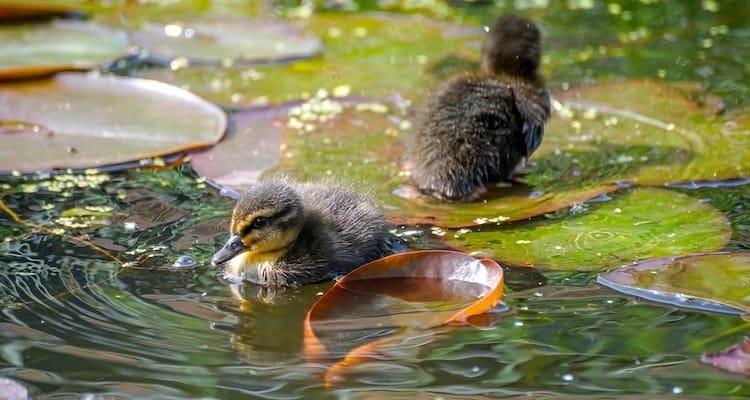
As we’ve shown in this article, building a pond is entirely possible as a DIY project. It could prove challenging at times but at the end you’ll be left with the incredible reward of your own garden pond to enjoy and relish for years to come. We’ve looked at what you’ll need to construct a garden pond, what can be gained from this and how this can be achieved. Once again, make sure that you undertake any necessary research and prepare well before delving into it. Best of luck!
FAQs
Q: How much pond liner do I need?
A: There are different formulas for working this out. One of the simplest equations is; overlap + overlap + depth + depth + width = total pond liner needed.
Q: How deep should a pond be?
A: It really depends on your preferences, but generally a pond should be at least 60cms in depth.
Q: What size pond pump do I need?
A: The pump should be able to circulate the entire water contents of the pond in two hours. So for a 4000 litre pond, you should purchase a pump that can move 2000 litres of water per hour.
Q: What are common problems that can arise with a pond during the summer?
A: During the warmer months of the year, water loss can occur due to increased evaporation. Fish gasping is another problem that can arise if oxygen levels drop too far because of hot weather. Further, plant growth could also choke the pond as plants seek more hydration. At the same time, algae growth can increase. To avoid or deal with any of these issues, make sure to research them before the summer starts.
Q: How long does a garden pond last?
Garden ponds often last for 20 years, if well looked after.
Sources
- http://ccerensselaer.org/environment/ponds/attracting-wildlife-to-your-pond/
- http://www.tetra-fish.com/pond/learning-center/get-educated/five-environmental-benifits.aspx
- https://pacificponds.com/pacific-ponds/8-things-to-consider-before-you-build-a-pond/
- https://www.rhs.org.uk/advice/profile?pid=839
- https://www.gardenersworld.com/plants/marginal-plants-for-ponds/
- https://pondinformer.com/best-oxygenating-pond-plants/
- http://www.pondexpert.co.uk/floating-plants-for-pond.html
- https://www.lilieswatergardens.co.uk/deep-water-marginal-pond-plants-c-2506_127_112.html
- http://www.bbc.co.uk/gardening/htbg2/flat/module4/pond_basics2.shtml
- https://homeguides.sfgate.com/kind-pump-need-small-fish-pond-96217.html
- http://www.bristol-aquarists.org.uk/
- http://www.gardensupermart.com/articles/garden-pond-pump.php
- https://www.pond-planet.co.uk/pond-building-guide-i37
- https://www.water-garden.co.uk/tech/pond-building-maintenance-advice/how-to-build-a-pond
- https://www.wikihow.com/Build-a-Backyard-Pond
- https://www.lakedoctors.com/emergent-plants/
- https://www.rhs.org.uk/advice/profile?PID=622
- https://www.gardenersworld.com/plants/attract-wildlife-to-your-garden-pond/



